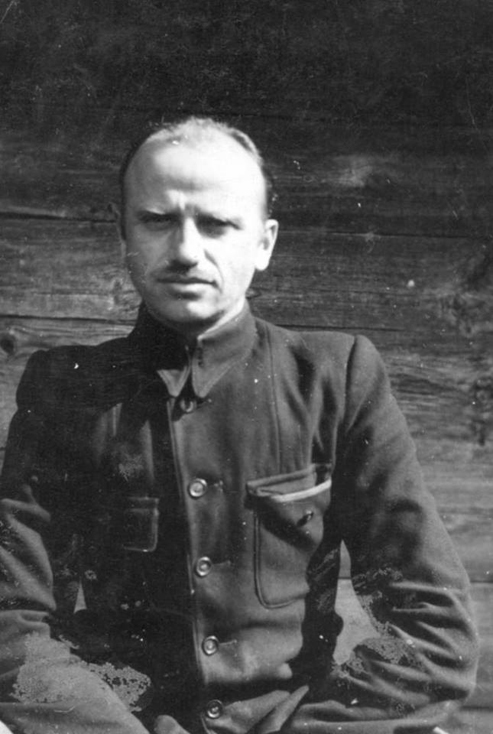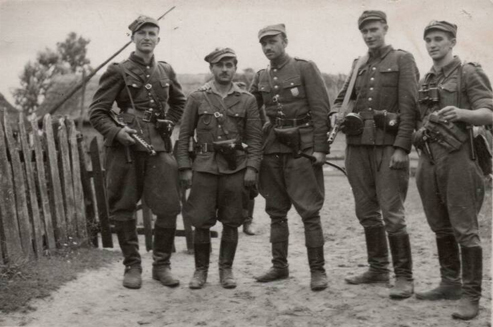A very similar thing happened in the case of Major Zygmunt Szendzielarz Łupaszka. Even today the name cannot be spoken by some, as he is still being regarded as a reactionary bandit, who ruthlessly murdered officials of the Ministry of Public Security (Urząd Bezpieczeństwa) and Communist activists. Why were the regime authorities were so afraid of him?Why did they decide to erase his name from Polish history? I will try to answer these questions based on information provided by Marian Kacprzak, a former guerrilla commander and a close observer of the events in the Masurian Lake District – and his diaries.
Zygmunt Edward Szendzielarz Łupaszka was born on 12 March 1910 in Stryj, into the family of a railway worker. He took over his pseudonym from Calvary Captain – Jerzy Dąbrowski, who during the Polish-Bolshie War in 1920 was a guerrilla commander leading anti-Soviet actions behind their front line.
After graduating from Cavalry NCO School in Grudziądz he was assigned to the 4th Uhlan Regiment. On the day World War II broke out, Lieutenant Szndzielarz was in charge of the Second Squadron of the regiment. After the defeat of the September Campaign he was offered a chance of escaping from the country and joining regenerated Polish Armed Forces in the West. But he decided against the idea.
In September 1943 Szendzielarz took charge of the V Vilnian Home Army Brigade, called The Brigade of Death, the biggest and the strongest of all the units in the area of Wilno Voivodeship and frightening two forces of occupation – the Germans and the Soviets in 1943-44. So, in July 1944 when the Reds were crossing the Eastern Polish border, the V Brigade was marching towards the West, and on 21 July it got to the Augustów Primeval Forest.
It was when Łupaszko heard of the arrest of the Commander of All Home Army Units in the Wilno area, General Aleksander “Wilk” Krzyżanowski, and his comrades, Łupaszko’s concerns about the dishonest intentions of the Russians came true. He stated his belief as follows: “I might be judged by history, but I do not want our soldiers to be hung on the walls and gates of Wilno.” By this time he knew that the People’s Commissariat for Internal Affairs (NKWD) was trying to find and catch his brigade. He re-named it the “Warsaw Brigade” and ordered his soldiers to change their pseudonyms in order to confuse the Soviets. He changed his own pseudonym to “Żelazny” (“Ironman”) as well.
In spite of all the actions taken, the Soviets managed to find them on 23August. Łupaszka, despite all the reassurance of the Soviets that the forces would be incorporated into the Berling Army, decided to disband the unit. He did not give up, though. He knew that he had to keep on harassing the enemy, and so he formed a unit with partisans after the long journey in the Wołkowsk Region in August 1944. He contacted the Commander of the Bialystok Home Army Area, Colonel Wladysław Liniarski “Mścisław”, and had him take charge of Łupaszko’s unit. In 1945 Szendzielarz reactivated the V Brigade within the Białystok Home Army Area, taking actions as a discretionary unit of the Army Area. On 7 September 1945 he was told to disband the brigade by the Commander of the Bialystok Home Army Area himself.
In mid-September 1945 Łupaszka became an active member of the conspiratorial operations at the Polish coast. He once again reactivated the V Brigade in mid-April 1946, which was suppose to operate within Pomerania and the Masurian Lake District. In September 1946 he managed to contact the VI Vilnian Home Army Brigade under the command of “Wiktor”, and later on “Młot”. The name “brigade” had more of a symbolic meaning and was meant to hark back to the tradition of Vilnian forces. The brigade was divided into three squadrons and a unit of Military Police. The main aim was to undertake all kinds of disruptive action against the emerging Communist government. All the actions taken by Łupaszka and his comrades were deeply rooted in the belief in the forthcoming victory and equity of the fight.
 In 1946 the unequal fight between Łupaszka’s units and the Red Army, the NKWD and all their Polish henchmen began. Like in the case of every civil war, combats were becoming more and more savage and cruel. Łupaszka attacked with the element of surprise, changing the position of units quite frequently. He and his men were considered trustworthy among local people. One has to remember that there was no Polish Army network by that time. They received some help from “trustworthy” people, such as from Zbigniew Jarosiński (“Puszczyk”), who was arrested by the Soviets and sentenced to 15 years in prison by the Regional Court in Olsztyn. He was released after Stalin’s death in 1957. He fought for his dignity and succeeded in having his sentence cancelled in 1991.
In 1946 the unequal fight between Łupaszka’s units and the Red Army, the NKWD and all their Polish henchmen began. Like in the case of every civil war, combats were becoming more and more savage and cruel. Łupaszka attacked with the element of surprise, changing the position of units quite frequently. He and his men were considered trustworthy among local people. One has to remember that there was no Polish Army network by that time. They received some help from “trustworthy” people, such as from Zbigniew Jarosiński (“Puszczyk”), who was arrested by the Soviets and sentenced to 15 years in prison by the Regional Court in Olsztyn. He was released after Stalin’s death in 1957. He fought for his dignity and succeeded in having his sentence cancelled in 1991.
Help for Łupaszka came from various different sources – from policemen, forest rangers, soldiers of the Polish People’s Army (LWP), and even from the officials of the Ministry of Public Security (UB) who quite often had a Polish Army background. Major Michał Wawyk “Cichy” and Second Lieutant Jan Romanowski were the most precious collaborates. They were… officers of the communist regime. “Cichy” was a director of the Scientific Regiment of the Internal Security Corps (KBW) in Szczytno, and Romanowski was a Commander in the Internal Security Army (WBW). Unfortunately, after a while they were exposed, and disappeared in unexplained circumstances, as happened with so many opponents of the Communists.
In the reports of the highest Communist officials, the combat actions of Łupaszka’s units were presented in a distorting mirror. Partisans were described as bestial tormentors who would finish off the wounded and injured. One can read a lot about it in writings devoted to the confirmation of Socialist government – which is not surprising. Even after 1989 some similar publications by Party historians were published. In the report of the Central Area branch office, cryptonym “Stocznia” (Shipyard), written on 1 July 1946 one can read that: “There is a strong forest group commanded by Major Łupaszka within the Masurian Lake District. Its range is from Brześć by the river Bug, to Chojnice in Pomerania. The group and major himself get on well with the Polish Army members, as well as with the local community, being liked and appreciated for their commitment”.
Author: Emilian Waluchowski /Pangea Magazine
Photos from historical collection



